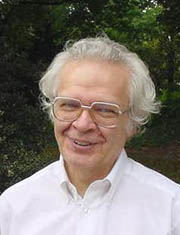Dr. Otto E. Rössler
Otto E. Rössler, M.D., Ph.D. Austrian, is Professor of Theoretical Biochemistry at the Institute for Physical and Theoretical Chemistry of the University of Tübingen, Germany and is notable for his work on chaos theory and his theoretical equation known as the Rössler attractor. His research focuses on theoretical biology, theoretical physics, mathematics, philosophy of science, media theory, and process engineering.
Otto earned his M.D. at the University of Tübingen in 1966. In the same year he got a postdoc position at the Max Planck Institute for Behavioral Physiology in Bavaria to continue collaboration with Carl-Friedrich von Weizsäcker on his own origin of life model of 1961. A collaboration with Konrad Lorenz there laid the foundation for his brain equation of 1973. In 1969, he started a visiting appointment at the Center for Theoretical Biology at SUNY-Buffalo collaborating there with Bob Rosen, the father of relational biology.
In 1973 he habilitated in theoretical biochemistry at the University of Tübingen. Two years later he got a stipend from the VW Foundation working with Israel Lieblich on the theory of emotional cross stimulation. In the same year he discussed his newly published theory of personhood acquisition (smile theory) with Gregory Bateson in Santa Cruz. Also in 1975, his friend Art Winfree introduced him to chaos. In 1976, he became a tenured University Docent and in 1979 a professor of Theoretical Biochemistry at the University of Tübingen. In 1994, he became the first Professor of Chemistry by state decree — a German invention. His protest led the state government to order his psychiatrization which he eschewed but he lost all grants for all collaborators and was with his wife — the first involuntary professor in medicine — expelled from their inherited home by the state administration.
He has held visiting positions at the University of Stuttgart (Theoretical Physics), Guelph (Mathematics) in Canada, the Center for Nonlinear Studies of the University of California at Los Alamos, the University of Virginia (Chemical Engineering), the Technical University of Denmark (Theoretical Physics), the Santa Fe Institute (Complexity Research) in New Mexico (which he was not allowed to consummate by Germany), the University of Art (Media Science) in Vienna, and the University of Rouen, France (with Christophe Letellier).
Throughout his career, Otto has authored around 500 scientific papers in fields as wide-ranging as biogenesis, deductive biology, origin of language, differentiable automata, bacterial brain, chaotic attractors, dripping faucet, heart chaos (with Reimara Rössler), aging theory (with Reimara Rössler), hyperchaos, nowhere-differentiable attractors (with Jack Hudson and Ichiro Tsuda), flare attractors, endophysics, micro relativity, Platonic computers, micro constructivism, recursive evolution, limitology, interface theory, Einstein completion of quantum mechanics, a proof of Everett’s theory, artificial universes, assignment conditions, the hypertext encyclopedia, Lampsacus hometown of all persons, blind-sight experiments in physics, world-change technology, the Gulliver effect, kryodynamics, cosmology.
He wrote eight books: Encounter with Chaos (with Jürgen Parisietal. 1992), Endophysics: The world as an Interface (1992, 1998), Jonas World – The Thinking of Child (with Reimara Rössler 1994, in German), The Flaming Sword (1996, in German), Medium of Knowledge – The Human Right for Information (with Artur P. Schmidt 2000, in German), Encouraging Lampsacus (with Wilfried Kriese 2001), Otto’s Impossible Talks/Let’s Start to Implement Little Errors (University of the Arts Berlin 2010), Neosentience – The Benevolence Engine (with Bill Seaman 2011), as well as the CD Descartes’ Dream (in German) and the artistic movie Long Live the People of the Revolution (with Jürgen Heiteretal).
He coedited Bifurcation Theory and Applications in Scientific Disciplines (the New York Academy of Sciences’ 1977 conference on chaos, with Okan Gurel), International Symposium on Information Physics (with Ichiro Tsudaetal 1992), Space Time Physics and Fractality: Festschrift in honor of Mohamed El Naschie on the occasion of his 60th birthday (with Peter Weibel and Garnet Ord 2005), Simultaneity – Temporal Structures and Observer Perspectives (with Susie Vrobeletal 2008).
Watch Otto Rössler’s Safety Experiment and Otto Rössler about sustainability and the future. Read Interview: Professor Otto Rössler Takes On The LHC. Read his papers Abraham-Solution to Schwarzschild Metric Implies That CERN Miniblack Holes Pose a Planetary Risk, A Rational and Moral and Spiritual Dilemma, and Einstein’s Equivalence Principle Has Three Further Implications Besides Affecting Time: T-L-M-Ch Theorem. Read his Scholarpedia profile, his ATOMOSYD profile, and his Wikipedia profile.
